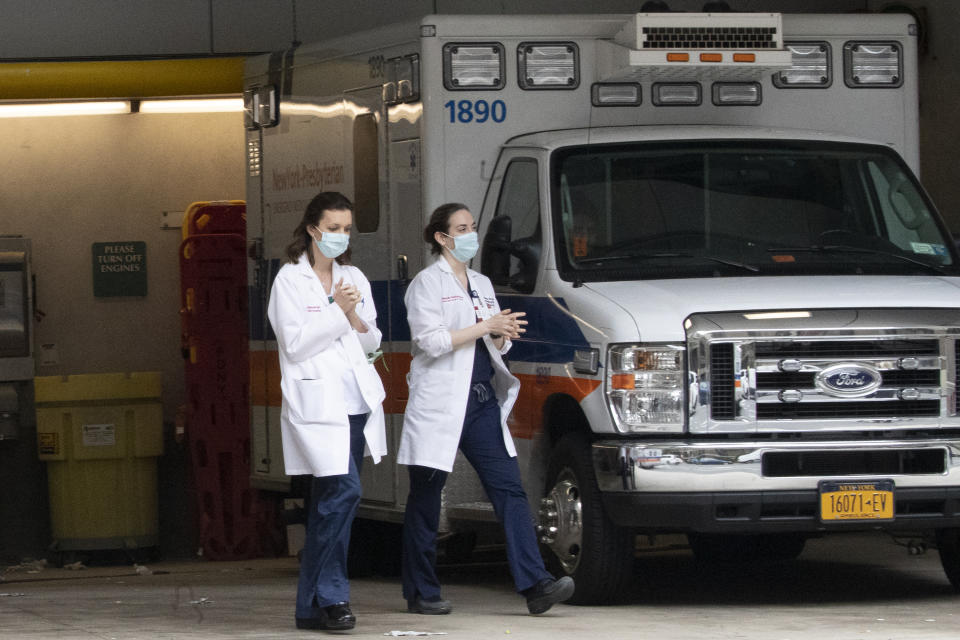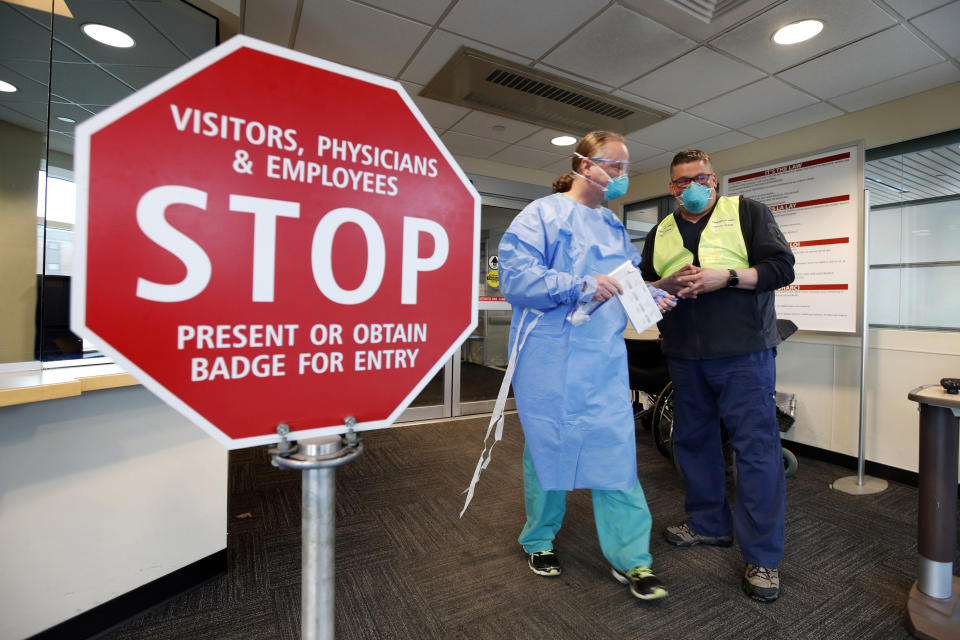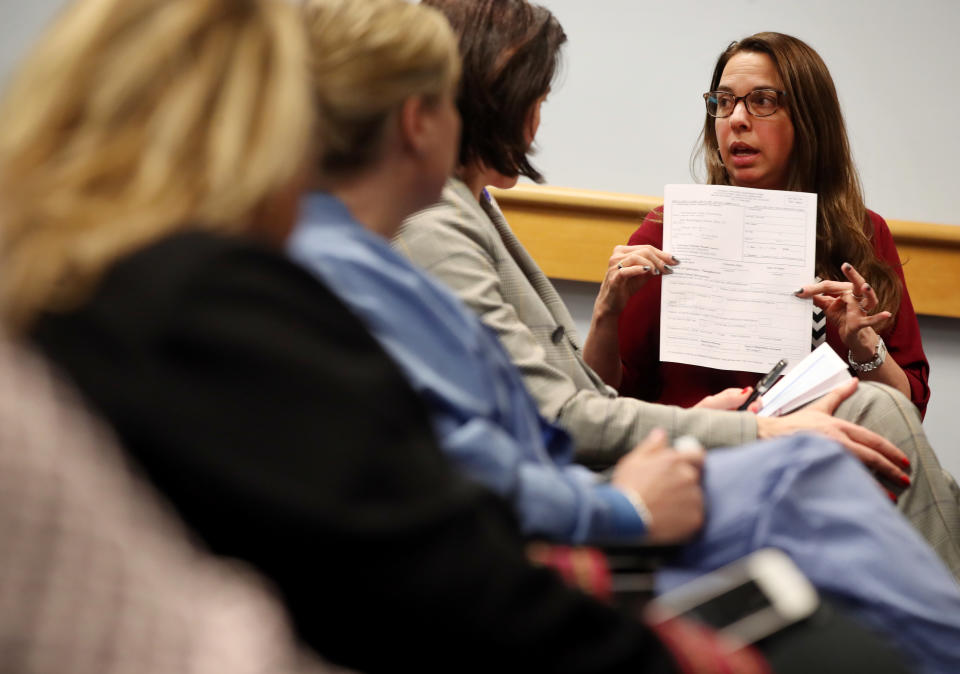Health care workers describe fear, confusion on the coronavirus frontlines
Life in the United States and around the world has effectively been put on hold as “social distancing” becomes essential to curtailing the spread of the coronavirus, which, as of Friday morning, had infected 14,250 people and killed 205 in the U.S., according to the latest data from Johns Hopkins University. Millions are working from home or are out of work entirely, while schools in much of the country are closed.
While the general public is being encouraged — or ordered — to stay indoors, doctors, nurses and other health care providers can’t work from home. They are facing a new reality of their own, as hospitals and clinics prepare for an imminent influx of coronavirus patients.
Yahoo News spoke to health care providers working in hospitals and emergency rooms in different parts of the country about their experiences on the frontlines in the fight against the coronavirus. All of them asked that their names not be used because they were not authorized by their employers to speak to the press.

A tale of two New York hospitals
Increased testing has resulted in a significant spike in the number of confirmed coronavirus cases across New York state this week. Between Wednesday and Thursday afternoon, the official number of confirmed statewide cases had jumped from roughly 3,000 to 5,200, with 3,615 of those in New York City. Coronavirus deaths in the city doubled overnight from 11 on Wednesday to 22 as of Thursday afternoon.
Over the past week or so, health care officials in New York and elsewhere have been revising policies and crisis response plans in response to a constantly evolving stream of new information and guidance from the Centers for Disease Control and Prevention. But some hospitals have been slower than others to keep up with the rapidly changing situation.
Yahoo News spoke to a medical resident at Mount Sinai, a leading medical center and teaching hospital, who also works at a community-based hospital in Queens on the weekends. She described a stark contrast between how the two hospitals have responded.
“It was pretty astonishing how behind they are in terms of visitor policies, masking sick patients, screening patients,” the resident said of the Queens hospital, where she worked last weekend. At that point, she said, Mount Sinai had begun implementing a policy to screen every stable person with coronavirus symptoms as soon as they arrive at the Manhattan hospital, to determine if they should even enter the building. Due to limited space, she said certain wings of the emergency room were being sectioned off for coronavirus patients.
During her shift at the hospital in Queens last weekend, she saw sick people walking in freely without any screening, as the emergency room quickly became “overcapacitated.” Triage tents were being set up on the main floor of the ER in an attempt to isolate the potential coronavirus patients.
While the recent spread and anticipated surge in coronavirus cases has prompted hospitals like Mount Sinai to spring into action with emergency policies and contingency plans, the resident admitted that “even [for] people in the medical field, I think we had a delayed reaction to it.”
“We’re so desensitized to a lot of things,” she said. “When it first started, I was kind of unfazed by it.”
Now she’s become acutely aware of her own exposure to the virus.
Like most of the general public, this resident said that she and her colleagues are only being tested for coronavirus if they become sick, and already a couple of residents have had to self-quarantine after coming down with symptoms. In an attempt to avoid losing more providers to home quarantine, work schedules have been revised to limit the number of residents and staff at the hospital at the same time.
“I worry about the exposure for sure,” she told Yahoo News. “Even though young people have the potential to get sick with it,” she’s less concerned about her own health than she is about potentially infecting others.
“I would never want to visit my grandma right now or my dad,” she said, adding that “outside of work, I’m not really seeing anybody.”

The ‘calm before the storm’
The spread of the coronavirus in Massachusetts has been slower than in New York, with health officials reporting a total of 328 confirmed cases across the state as of Thursday, and 71 in Suffolk County, which includes Boston. But that hasn’t stopped Boston hospitals from enacting their own emergency plans, including barring visitors, canceling elective procedures and scouting out additional bed space to accommodate an anticipated surge of patients.
“I feel like it hasn’t really started yet, so it’s this weird calm before the storm,” said a medical resident at one Boston hospital. “It’s going to get so much worse.”
This resident, who asked that her name not be used because she’s not authorized to speak to the press, works on the hospital’s medical floor treating anyone who is admitted through the emergency room, including those suspected of having the coronavirus. Examining those patients requires a uniform of personal protective equipment — including gowns, gloves and masks — that must be put on and taken off in a specific order.
Like others who spoke to Yahoo News, the resident described receiving near-hourly updates on new policies being implemented by the hospital in response to changing guidance from the CDC.
While the wave of coronavirus patients has not yet hit, the resident said her hospital is already experiencing supply shortages.
“They’re completely out of masks, shields, gloves in the ER,” she said. “People are having to reuse supplies, trying to figure out how to get new supplies. It’s kind of insane. … That’s as of the past couple of days.”
While the resident said she feels “very supported by the hospital,” the level of uncertainty that still exists about the coronavirus as it continues to spread has left her feeling “absolutely terrified.”
“I have never been scared to go to the hospital until this past week,” she said. “And then to see people being so cavalier, running around and not distancing … is so infuriating.”

Mental illness ‘doesn’t stop in the midst of a crisis’
As hospitals prohibit visitors, cancel elective procedures and take various other measures to free up bed space, equipment and personnel to treat coronavirus patients, they also must continue to provide other emergency services.
“One thing we hear in the media all the time is ‘Don't go to the ER unless you’re really sick,’ but in a community-based hospital, people don't have a choice,” said a behavioral health specialist who works in the psychiatric department of the emergency room at a community hospital in Baltimore. She does psychiatric evaluations for people who come to the ER with acute mental health concerns. “Obviously mental [illness] doesn’t stop in the midst of a crisis, so we still need to be able to treat those patients as well.”
The Baltimore Sun reported Thursday that there were 107 total confirmed coronavirus cases in Maryland — eight in the city of Baltimore.
Under the latest guidance, the behavioral health specialist is not evaluating any patients suspected of being infected with COVID-19. But the psychiatric department continues to operate within the emergency room, where a growing number of patients have been admitted on suspicion of coronavirus over the past few days. Outside, tents are being set up with additional beds in anticipation of a coming surge.
At first she wasn’t bothered by having to work alongside suspected COVID-19 patients in the emergency room, but her attitude has evolved along with the crisis. One turning point occurred over the weekend when, midway through her Saturday shift, everyone working in the ER was told they had to wear surgical masks.
“It was a really stark thing to be in your office and walk out to go see a patient and everyone is wearing a mask — environmental services, housekeeping, front desk, security. That was definitely a moment when you felt a shift,” she said. By Monday the guidance had changed, requiring instead that masks be worn only by staff directly treating patients suspected of COVID-19.
While on the phone with Yahoo News Thursday morning, she received another email from hospital leadership advising staff that personal protective equipment, including masks, was now prohibited from being worn in the hallways, cafeterias and other common areas as well as outside on hospital grounds. The email, which was reviewed by Yahoo News, states, “At this time, all the research and information from the CDC indicates that there is no clinical reason for masks” and other personal protective equipment to be worn in those areas of the hospital.
“It just speaks to the fluidity of the situation,” she said.
New information released by the CDC on Wednesday that the coronavirus, contrary to initial indications, is causing severe illness in younger patients as well as older ones has added a new layer of concern.
“It’s a reminder that we all have to be cautious to protect each other and ourselves,” she said.
At home, that need for caution has translated into more handwashing and disinfecting of frequently touched surfaces, like phones and doorknobs. She’s also noticed a change in her behavior at work. Where she previously spent time chatting in the hallways with nurses and attending physicians, she said that recently she’s found herself forgoing social interactions and going straight to her office to fill out paperwork. She’s even started phoning the doctor who works in the next room for conversations that previously would have taken place in person.
“I like to be one who talks face to face,” she said. “But also, I don't like feeling scared in my own job.”
_____
Read more from Yahoo News:




